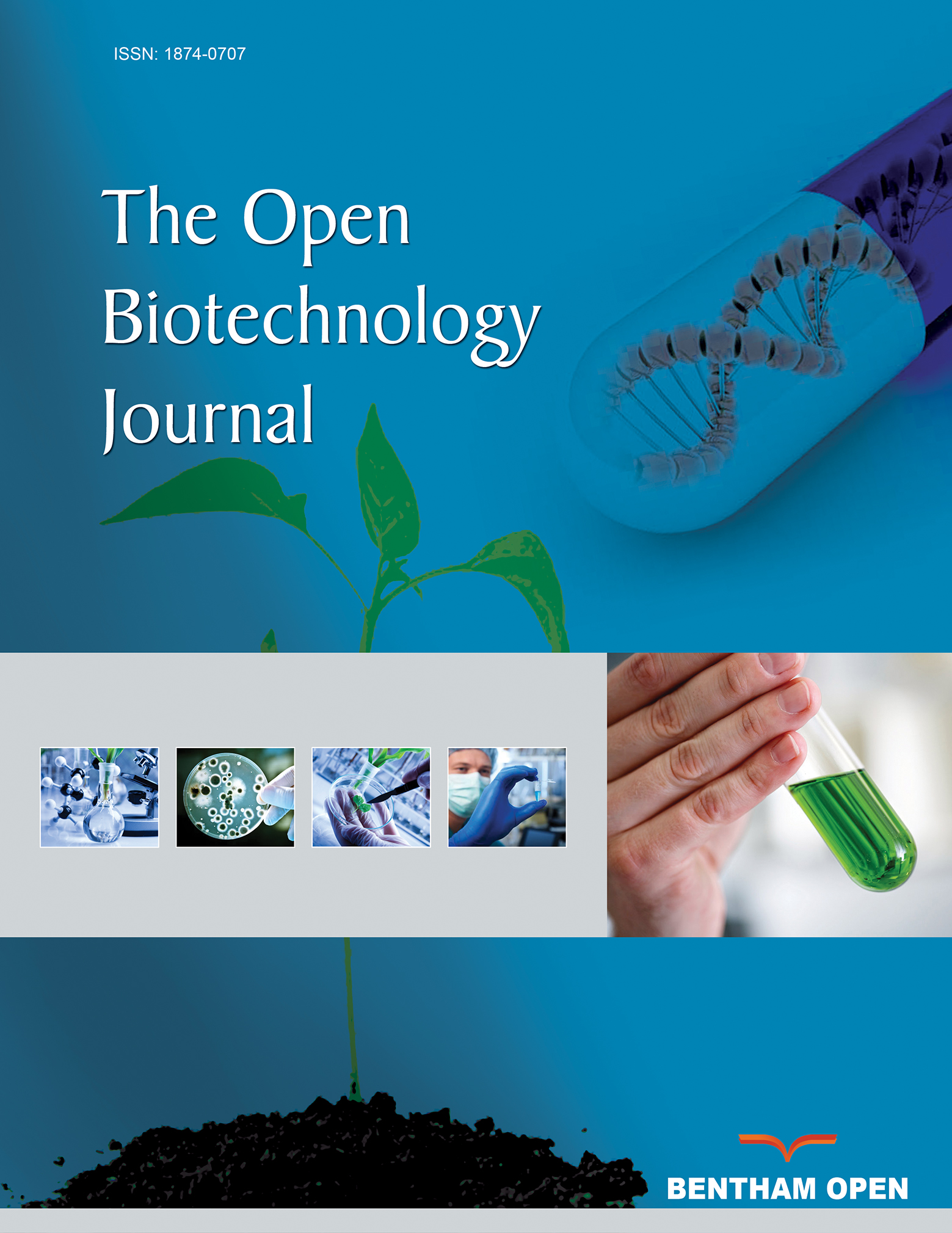All published articles of this journal are available on ScienceDirect.
The Effectiveness of UV-C Light for Inactivating Listeria monocytogenes Bacteria and its Impact on Apple Juice
Abstract
Background:
Apple juice is useful for preventing cardiovascular disease, degenerative disease, and cancer. The supply of apple juice is often contaminated with microbes due to raw materials and different processing methods. This study aimed to determine the effectiveness of inactivating L. monocytogenes bacteria using UV-C light by observing its impact on vitamin C content, pH, and color of apple juice.
Methods:
The research sample was Manalagi apple juice contaminated with L. monocytogenes bacteria. The treatment used UV-C with a wavelength of 185-280 nm and the optimum intensity at 256 nm. The light intensity used for the treatment was 0-125 mW/cm2, with treatment times of 30 minutes and 60 minutes.
Results:
The results showed that the inactivation of bacteria with a light intensity of 125 mW/cm2 for 30 minutes reduced the number of bacteria by 0.49 ± 0.02 log10, while the inactivation for 60 minutes was able to reduce the number of bacteria by 1.01 ± 0.02 log10. Treatment using UV-C reduced the content of vitamin C, raised the pH, and changed the color of apple juice.
Conclusion:
Treatment using UV-C with higher intensity was effective in reducing the number of large bacteria but had the potential to decrease the vitamin C content and change the color of apple juice to brown. Treatment using UV-C with an intensity of 100 and 125 mW/cm2 affected the smell of apple juice.
1. INTRODUCTION
Apples are often associated with dietary programs due to their antioxidant properties, especially polyphenols and vitamin C. These properties are considered beneficial because they contribute to reducing the risk of coronary heart disease, carcinogenesis, and the aging process and inhibiting the oxidation of human low-density lipoproteins [1, 2]. Recent studies have shown an increasing interest in consuming fruit juices with high natural antioxidant content, especially vitamins and polyphenols. The quality of apple juice is influenced by various factors, such as sterilization temperature, processing waiting time, processing technique [3], storage conditions [4], and processing time [5].
Microbes often contaminate apple juice due to contaminated apple raw materials [6-8], processing preparation, packaging, and storage processes. Cleanliness during processing can make apple juice susceptible to microbial contamination. Microorganisms can contaminate fruits if they come into contact with water, soil, and dust during the harvest or postharvest processing. As a result, apples have been found to harbor different microorganisms, including human and plant pathogens [9].
L. monocytogenes is a type of Gram-positive bacteria, and consuming contaminated food is one way of this bacteria transmission [10]. In the United States, every year, there are about 1600 diseases caused by L. monocytogenes, with a mortality rate of 16% [11]. In 2014-2015, there was a multistate outbreak of L. monocytogenes associated with caramel apples, which caused 35 diseases in 12 states in the United States [12]. The events above are evidence that L. monocytogenes is a threat to the safety of fresh food and beverage products, especially those produced from the fruit. L. monocytogenes bacteria can live and grow at cold temperatures in fresh produce. For instance, the condition of L. monocytogenes bacteria on lettuce remains stable with storage for five days at 5◦C [13]. L. monocytogenes are considered to be able to survive under various stressful conditions found in the food matrix [14].
Inactivating pathogenic microorganisms and enzymes is generally done through thermal processing to extend shelf life. Thermal processing of food, however, can reduce sensory and nutritional qualities [15]. The physical preservation method using UV light is an alternative to preserving food in solid and liquid forms. Treatment using low-intensity ultraviolet light is a non-thermal preservation method [16] to minimize quality degradation in terms of taste, aroma, color, and nutritional content [17] compared to thermal food processing. Another advantage of UV light is that there are no toxic by-products, inorganic contamination, and furan formation, it is easy to use, and it is less expensive than thermal processing.
UV-C rays are in the wavelength range of 200-280 nm, which is part of the UV rays. UV light is able to reduce microorganisms, including bacteria, yeast, fungi, and viruses [18]. Treatment technology using UV-C has been found to reduce the number of pathogenic microorganisms to 5 log10 transmitted through milk [19]. UV-C treatment with a dose of 13.75 mJ/cm2 has reduced the number of Salmonella typhimurium microorganisms in pineapple juice by more than 5.0 log10 [20]. UV-C treatment ranging from 0.2 to 3.6 kJL−1 has reduced the number of microorganisms in fruit juices by 1.0-3.0 log10 [21]. However, decontamination using UV-C has limitations in efficacy due to the low UV penetration in fruit juices. The low decontamination is due to the high absorption coefficient of natural substances in the UV range, the presence of solids in the juice, turbidity, and the microbial population, thereby reducing its efficacy [22]. Increasing the intensity of UV-C light for bacterial inactivation will cause a thermal effect, resulting in adverse effects on the sensory and nutritional quality of food, one of which is on vitamin C, which is changed to determine the eligibility limit. This study aims to determine the effectiveness of UV-C light for the inactivation of L. monocytogenes bacteria in apple juice and its effect on vitamin C content, pH, and color of the juice after it is stored for 48 hours at 5oC.
2. MATERIALS AND METHODS
2.1. Sample Preparation
This study used apple juice samples from Manalagi apples overgrown with L. monocytogenes bacteria. Apples were obtained from apple farmers in Batu, Indonesia, while L. monocytogenes were obtained from the Laboratory of Microbiology, Brawijaya University, Malang-Indonesia.
Apples used as juice were fresh apples without wax. All fruits selected had similar commercial maturity, i.e., under optimal maturity conditions for fresh fruit or storage. All apples were picked from the trees four days before juicing and temporarily stored in the freezer at about 5oC. The apples weighed an average of 200 g without any cuts, bruises, or scars. The apples were then rinsed in cold tap water and dried on the counter overnight to balance the apples' temperature with room temperature. Next, the apples were blended using a Philips Juicer HR-1832, which had been sterilized to produce apple juice. During the blending process, the temperature was controlled not to exceed 50oC. The apple juice obtained was later sterilized using a pulsed electric field. Sterilized apple juice was given 1.0 mL or as much as 233.3 x 107 CFU/mL Listeria monocytogenes bacteria and then incubated in an incubator for 24 hours at 37oC. The number of bacteria before being treated was 233.3 x 107 CFU/mL.
2.2. Bacterial Growth in Apple Juice
Bacteria were aseptically inoculated with a straight inoculating needle on a slanted surface of the medium in a straight direction from bottom to top. The culture was incubated in an incubator at 37°C for 24 hours. A total of 1.0 mL of bacteria was taken in nutrient broth medium. Bacteria were implanted into apple juice that had been sterilized. Bacteria in apple juice were incubated at 37°C for 24 hours.
2.3. Treatment Using UV-C
Bacteria growing on apple juice were treated using UV-C light with a wavelength of 185-280 nm with a maximum intensity of 265 nm. The treatment was conducted with an intensity of 0, 50, 75, 100, and 125 mW/cm2 for 30 minutes and 60 minutes. The treatment was carried out from two sides, as shown in Fig. (1), to compensate for the decrease in light intensity due to absorption. Each treatment was given repetition five times. After being treated using UV-C, the apple juice was stored in a freezer at 5oC for 48 hours. The sample holder was made of glass with a thickness of 0.5 mm, a height of 7 cm, and a diameter of 12 cm, with the top surface exposed when irradiated. The sample container was filled with juice with a height of 6 cm and a diameter of 11.9 cm or a volume of 667.6 cm3.
2.4. Counting The Number of Bacteria
The calculation of the number of bacterial colonies was carried out using a colony counter after it was stored in the freezer. Then, 1.0 mL of suspension from apple juice was taken and then put into a sterile flacon bottle containing 9.0 mL of distilled water and homogenized. Afterward, 1.0 mL was taken and put into another sterile flacon bottle containing 9.0 mL as a dilution process. The dilution was repeated as many times as needed. After dilution, 1.0 mL of the suspension resulting from the dilution was taken and spread into a sterile petri dish containing still liquid Plate Count Agar (PCA) media. After the PCA media solidified, the Petri dishes were incubated upside down for 24 hours at 37°C.
2.5. Vitamin C Content Testing
Measurement of vitamin C content was carried out using the UV-Vis spectrophotometry method developed by Mussa and El Sharaa [23]. Apple juice absorbance was measured at a UV-Vis wavelength of 256 nm. The measurement was made after the apple juice was stored in the freezer. The method of measurement was done by inserting 1.0 gram of sample in a volumetric flask and mixing it with 50 ml of distilled water. Next, the absorbance was measured using a UV-VIS T70 Spectrophotometer manufactured by PHYWE. Afterward, vitamin C content was calculated using the regression formula generated from the calibration curve.
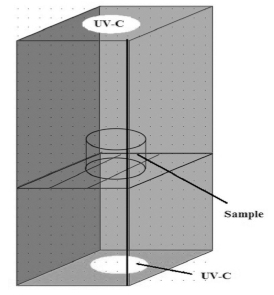
y = 0.07795x + 0,01771
Where y is the absorbance at a wavelength of 256 nm, while x is the ascorbic acid concentration (mg/100mL).
2.6. pH Measurement
The pH measurement of apple juice was carried out after it was stored in the freezer. The pH of apple juice was measured using a Digital pH Meter Smart Sensor AS-218.
2.7. Statistical Analysis
Analysis of data on the decrease in the number of bacteria, vitamin C content, and pH was performed using the Analysis of Variance (ANOVA) statistic. Follow-up tests were carried out using the Duncan Multiple Range Test (DMRT). The ANOVA analysis was performed to examine the mean differences between groups, while the DMRT test was to determine the significance of the differences between each treatment.
3. RESULTS AND DISCUSSION
3.1. Reduction of Bacteria Count
UV-C light treatment on apple juice caused reflection, scattering, absorption, and transmission events. The effect that caused bacterial deactivation was found to be the absorption of UV-C rays by bacteria that grow in apple juice. Absorption of UV-C light at low intensity resulted in a photochemical effect, but if the light intensity increased, a photothermal effect would accompany it. The photochemical effect could produce reactive oxygen, damaging the bacterial cell membrane. Therefore, UV-C treatment on apple juice inhibited the growth of L. monocytogenes bacteria. Fig. (2) shows the effect of UV-C light treatment on the decrease in the number of bacterial colonies. The higher the intensity of UV-C light applied and the longer the treatment time, the more significant the reduction in the number of bacteria. Treatment with an intensity of 125 mW/cm2 for 30 reduced the number of bacterial colonies by 0.5 ± 0.02 log10, while the treatment for 60 minutes reduced the number of bacteria by 1.00 ± 0.01 log10. The statistical analysis showed that treatment with a 50-125 mW/cm2 intensity for 30 and 60 minutes significantly reduced the number of bacterial colonies (p≤0.05). However, in general, the reduction in the number of bacteria was slow due to the presence of solids and particles in the apple juice.
Changes in light intensity used for treatment significantly reduced the number of bacteria, but overall the reduction was not optimal. The low reduction in the number of bacteria was due to L. monocytogenes bacteria having optimum absorbance at a wavelength of 525 -700 nm [24] and its ability to form biofilms [25], making it resistant to UV-C radiation [26]. The low reduction was also due to the ability of UV-C rays to penetrate apple juice because it was absorbed by natural substances contained in the juice and reflected by solids [22]. The same results were reported by the research of Adhikari, et al. [27], which showed that exposure to UV light at a dose of 3.75 kJ/m2 reduced the number of L. monocytogenes bacteria by 1.6 log10 on the apple surface. UV-C exposure for 720 seconds, with a total dose of 7.8 x 102 mJ/cm2, decreased the L. monocytogenes population on frozen red raspberry surfaces by 1.5 log10 [28]. UV-C radiation in apple juice at a dose of 4 mJcm-2 reduced the number of L. monocytogenes bacteria by 1.25 log10 [29]. Meanwhile, sterilization using a microwave with a power of 900 watts for 40 seconds reduced the number of bacterial colonies from 100 x 103 CFU/ml to 1 x 101 CFU/ml [30]. However, the juice temperature increased to almost 100oC, so that it could reduce the content of natural substances.
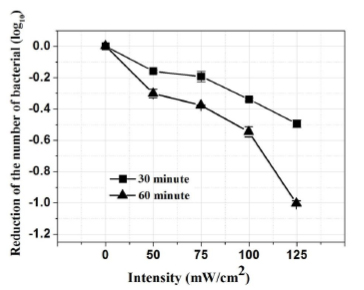
3.2. Vitamin C Content
From the determination of the wavelength obtained, vitamin C has maximum absorption at a wavelength of 256 nm. The wavelength of 256 nm is in the working region of UV-C light. Therefore, the absorption of UV-C rays by vitamin C is quite large, affecting the vitamin C content in apple juice. Fig. (3) shows the decrease in vitamin C content due to treatment using UV-C light with an 0-125 mW/cm2 intensity for 30 and 60 minutes. Treatment with a 125 mW/cm2 intensity for 30 minutes decreased apple juice's vitamin C content from 9.76 ± 0.94 mg/100mL to 3.30 ± 0.16 mg/100mL, which was a total decrease of 66%. Treatment with a 125 mW/cm2 intensity for 60 minutes decreased the vitamin C content from 9.76 ± 0.94 mg/100mL to 2.77 ± 0.12 mg/100mL, which was a total decrease of 71.6%. Statistical analysis showed that treatment with 50-125 mW/cm2 intensity for 30 and 60 minutes significantly (p≤0.05) reduced the vitamin C content of apple juice. This high decrease occurred due to high absorption, causing vitamin C to be degraded.
Treatment using UV-C with a wavelength of 185-280 nm reduced the vitamin C content. The percentage decrease was up to 71.6% for the treatment with an intensity of 125 mW/cm2 for 60 minutes. The magnitude of the reduction of vitamin C occurred because the UV-C ray operating area was at the optimum absorbance of vitamin C, which was 256 nm. The amount of energy of UV-C photons absorbed by vitamin C caused the oxidation of vitamin C, further degrading it. Previous studies have reported that UV-C treatment at a dose of 100 mJ/cm2 reduced vitamin C content by 18% [31]. Treatment using UV-C has significantly reduced the vitamin C content in fresh pineapple [32]. This was further proven by Bal and Kok [33], stating that the vitamin C content in kiwi fruit juice irradiated with UV-C and stored for 40 days was lower than that in control. Meanwhile, with storage for 200 days, the vitamin C content was greater than that in control. The above conditions indicated that the treatment using UV-C rays reduced the content of vitamin C, but when stored, the decrease in vitamin C was lower than without treatment. The effect of UV-C treatment on vitamin C metabolism showed that total vitamin C was significantly higher at ~54% after seven days of storage [34]. Meanwhile, sterilization using a magnetic field strength of 30 kV/cm could retain vitamin C by 39.8% [35]. Conventional sterilization by heating at 75oC decreased the vitamin C content from 23.48 to 6.38 mg/100ml after being stored for four months [36].
3.3. Apple Juice pH
The effects of treatment using UV-C rays on the pH of fruit juices have not been widely reported. However, the treatment of apple juice overgrown with L. monocytogenes bacteria was found to change the pH level. Fig. (4) shows that the treatment using UV-C light on apple juice overgrown with L. monocytogenes caused the pH of the apple juice to increase. The pH of untreated apple juice was 4.53 ± 0.06 after it was irradiated with an intensity of 125 mW/cm2 for 30 minutes to 5.33 ± 0.16, while treatment for 60 minutes made the pH of apple juice increased to 5.77 ± 0.60. In treatment for 30 minutes, an increase in pH occurred when the apple juice was treated with an intensity of 75 mW/cm2, while in treatment for 60 minutes, an increase in pH occurred when the apple juice was treated with an intensity of 50 mW/cm2. Statistical analysis showed that irradiation with 100 and 125 mW/cm2 intensity for 30 minutes and 50-125 mW/cm2 intensity for 60 minutes significantly increased the pH of apple juice (p≤0.005).
The effect of UV-C light treatment on pH has not been widely reported; it is generally considered that UV-C treatment does not cause changes in pH. It is assumed that changes in pH in this study were related to the presence of bacteria and vitamin C content. Fig. (5) shows an inverse relationship between the number of bacteria and pH. Most of the bacteria have a lower pH; conversely, fewer bacteria have a higher pH. There has been no research linking the presence of L. monocytogenes bacteria with the pH of apple juice. However, in a different case, it has been reported that more bacteria in early childhood larvae have a low pH, while few bacteria have a high pH [37].
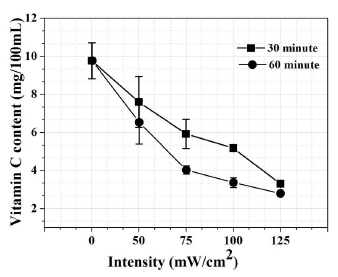
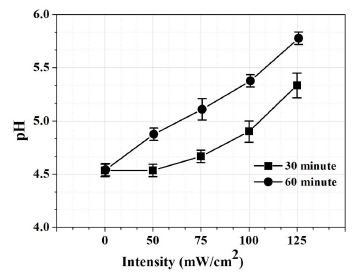
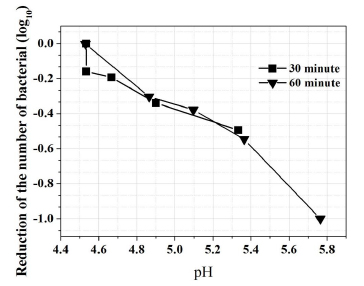
3.4. Apple Juice Color Change
Treatment using UV-C on apple juice grown with L. monocytogenes bacteria affected the color of the juice after it was stored for 48 hours. Fig. (6) shows the color of apple juice, which was treated using UV-C light with an 0-125 mW/cm2 intensity for 30 minutes and 60 minutes. Part (a) is the color of apple juice before it was treated and stored. Part (b) is the color of apple juice which was treated for 30 minutes with an 0-125 mW/cm2 intensity. Part (c) is the color of apple juice which was treated for 60 minutes with an 0-125 mW/cm2 intensity. A striking color change occurred in treatments with a 100 mW/cm2 and 125 mW/cm2 intensity for 30 minutes and 60 minutes, respectively. The accompanying thermal effect caused a color change in the treatment with a 100 and 125 mW/cm2 intensity.
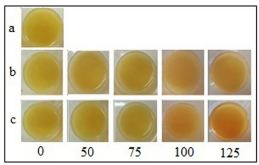
Treatment using UV-C with an intensity of 75 mW/cm2 and below did not significantly affect the color of apple juice, but radiation with an intensity of 100 mW/cm2 did. Identical conditions have been reported, suggesting that treatment using UV-C light caused browning during storage, and extension of treatment time resulted in increased browning of fresh-cut pineapples [32]. Meanwhile, Teja et al. [38] suggested that UV-C radiation did not significantly change the color. The color changes that occurred at the intensity of 100 and 125 mW/cm2 in this study were due to the occurrence of thermal effects that accompanied the photochemical effect, thus causing some natural substances to degrade, which made the juice color turn brown.
CONCLUSION
UV-C rays have the potential to be used for the sterilization of apple juice grown with L. monocytogenes bacteria. The sterilization of apple juice containing bacteria caused a decrease in vitamin C content, an increase in pH, and a change in the color of the juice. Reducing the number of bacteria could be optimized by extending the treatment time but not increasing the UV-C light intensity to 100 mW/cm2 and above. Changes in treatment time did not change the color of apple juice, while an increase in light intensity could cause color changes.
LIST OF ABBREVIATIONS
| ANOVA | = Analysis of Variance |
| DMRT | = Duncan Multiple Range Test |
| UVC | = Ultra Violet C |
AUTHORS' CONTRIBUTIONS
The corresponding author contributed to the process of data collection, data analysis, and script writing.
ETHICS APPROVAL AND CONSENT TO PARTICIPATE
Not applicable.
HUMAN AND ANIMAL RIGHTS
No humans or animals were used in the studies that are the basis of this research.
CONSENT FOR PUBLICATION
Not applicable.
AVAILABILITY OF DATA AND MATERIALS
The article data was obtained from research results at the Biophysics Laboratory of the State Islamic University of Maulana Malik Ibrahim Malang-Indonesia.
FUNDING
The research received funding from the Ministry of Religion of the Republic of Indonesia through the State Islamic University of Maulana Malik Ibrahim Malang-Indonesia.
CONFLICT OF INTEREST
The author declares that there is no conflict of interest, either financial or otherwise.
ACKNOWLEDGEMENTS
The author would like to thank the Ministry of Religion of the Republic of Indonesia and the State Islamic University of Maulana Malik Ibrahim of Malang.

